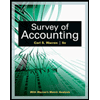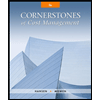
(a)
Compute the missing terms.
(a)
Explanation of Solution
Profit margin: This ratio gauges the operating profitability by quantifying the amount of income earned from business operations from the sales generated.
Formula of profit margin:
Investment turnover: This ratio gauges the operating efficiency by quantifying the amount of sales generated from the assets invested.
Formula of investment turnover:
Formula of ROI according to Dupont formula:
Residual income: The remaining income from operations after deducting the desired acceptable income is referred to as residual income.
Formula of residual income:
| Income from operations | XXX |
| Less minimum acceptable income from operations as a percent of invested assets | XXX |
| Residual income | XXX |
Table (1)
1)
Compute income from operations.
2)
Compute invested assets.
Note: Refer to missing amount (a) for value of income from operations.
3)
Compute investment turnover.
4)
Compute sales value.
5)
Compute sales value.
Note: Refer to missing amount (d) for value of sales.
6)
Compute ROI.
Note: Refer to missing amount (e) for value of invested assets.
7)
Compute income from operations.
8)
Compute profit margin.
Note: Refer to missing amount (g) for value of income from operations.
9)
Compute investment turnover.
10)
Compute ROI.
11)
Compute profit margin.
12)
Compute investment turnover.
(b)
Ascertain the residual income of for each division
(b)
Explanation of Solution
1)
Ascertain the residual income of N Division.
Step 1: Compute minimum acceptable income from operations as a percent of invested assets for N Division.
Note: Refer to missing amount (b) of part (a) for value of invested assets.
Step 2: Determine residual income of N Division.
| Particulars | Amount ($) |
| Income from operations | $60,200 |
| Less minimum acceptable income from operations as a percent of invested assets | 41,280 |
| Residual income | $18,920 |
Table (2)
Note: Refer to missing amount (a) of part (a) for value of income from operations, and Step 1 for value and computation of minimum acceptable income.
2)
Ascertain the residual income of S Division.
Step 1: Compute minimum acceptable income from operations as a percent of invested assets for S Division.
Note: Refer to missing amount (e) of part (a) for value of invested assets.
Step 2: Determine residual income of S Division.
| Particulars | Amount ($) |
| Income from operations | $51,300 |
| Less minimum acceptable income from operations as a percent of invested assets | 36,000 |
| Residual income | $15,300 |
Table (3)
Note: Refer to Step 1 for value and computation of minimum acceptable income.
3)
Ascertain the residual income of E Division.
Step 1: Compute minimum acceptable income from operations as a percent of invested assets for E Division.
Step 2: Determine residual income of E Division.
| Particulars | Amount ($) |
| Income from operations | $102,000 |
| Less minimum acceptable income from operations as a percent of invested assets | 81,600 |
| Residual income | $20,400 |
Table (4)
Note: Refer to missing amount (g) of part (a) for value of income from operations, and Step 1 for value and computation of minimum acceptable income.
4)
Ascertain the residual income of W Division.
Step 1: Compute minimum acceptable income from operations as a percent of invested assets for W Division.
Step 2: Determine residual income of W Division.
| Particulars | Amount ($) |
| Income from operations | $89,600 |
| Less minimum acceptable income from operations as a percent of invested assets | 67,200 |
| Residual income | $22,400 |
Table (5)
Note: Refer to missing amount (g) of part (a) for value of income from operations, and Step 1 for value and computation of minimum acceptable income.
(c) 1
Ascertain the profitable division in terms of ROI.
(c) 1
Explanation of Solution
The division with highest return on investment is considered as the most profitable division. Hence, N Division is the most profitable division with highest ROI of 17.5%.
(c) 2
Ascertain the division with highest residual income
(c) 2
Explanation of Solution
The division with highest residual income is considered as the most profitable division. Hence, W Division is the most profitable division with the highest residual income of $22,400.
Want to see more full solutions like this?
Chapter 24 Solutions
FINANCIAL&MANAGERIAL ACCOUNTING(LL)W/AC
- Don't use ai. A company has the following data: Cash: $50,000Accounts Receivable: $30,000Inventory: $60,000Current Liabilities: $70,000a) What is the company’s acid-test ratio?b) Is the company in a strong liquidity position based on this ratio?arrow_forwardQuestion 5:A company has the following data: Cash: $50,000Accounts Receivable: $30,000Inventory: $60,000Current Liabilities: $70,000a) What is the company’s acid-test ratio?b) Is the company in a strong liquidity position based on this ratio?arrow_forwardQuestion 5: Acid-Test RatioA company has the following data: Cash: $50,000Accounts Receivable: $30,000Inventory: $60,000Current Liabilities: $70,000a) What is the company’s acid-test ratio?b) Is the company in a strong liquidity position based on this ratio?arrow_forward
- Question 4: Depreciation (Straight-Line Method)A company purchases machinery for $50,000. The estimated salvage value is $5,000, and the useful life is 10 years. a) Calculate the annual depreciation expense.b) What will the book value of the machinery be after 4 years?arrow_forwardInventory Valuation (FIFO Method)A company had the following inventory transactions during the month: Beginning inventory: 100 units @ $10 eachPurchase: 200 units @ $12 eachPurchase: 150 units @ $13 eachAt the end of the month, 250 units remain in inventory. Calculate the value of the ending inventory using the FIFO method. explainarrow_forwardNeed assistance without use of ai.arrow_forward
- Depreciation (Straight-Line Method)A company purchases machinery for $50,000. The estimated salvage value is $5,000, and the useful life is 10 years. a) Calculate the annual depreciation expense.b) What will the book value of the machinery be after 4 years?arrow_forwardA company has the following data: Cash: $50,000Accounts Receivable: $30,000Inventory: $60,000Current Liabilities: $70,000a) What is the company’s acid-test ratio?b) Is the company in a strong liquidity position based on this ratio?arrow_forwardDon't want AI answerarrow_forward
- XYZ Corporation produces a product that sells for $30 per unit. The variable cost per unit is $18. Fixed costs for the year are $72,000. a) What is the contribution margin per unit? b) What is the contribution margin ratio? c) What is the break-even sales in dollars?arrow_forwardI need solution with step by step....?!arrow_forwardQuestion 1: Break-Even Analysis A company sells a product for $25 per unit. The variable cost per unit is $15, and the total fixed costs are $50,000. a) How many units must the company sell to break even? b) If the company wants a profit of $10,000, how many units must it sell?arrow_forward
 Managerial AccountingAccountingISBN:9781337912020Author:Carl Warren, Ph.d. Cma William B. TaylerPublisher:South-Western College Pub
Managerial AccountingAccountingISBN:9781337912020Author:Carl Warren, Ph.d. Cma William B. TaylerPublisher:South-Western College Pub Financial And Managerial AccountingAccountingISBN:9781337902663Author:WARREN, Carl S.Publisher:Cengage Learning,
Financial And Managerial AccountingAccountingISBN:9781337902663Author:WARREN, Carl S.Publisher:Cengage Learning, Survey of Accounting (Accounting I)AccountingISBN:9781305961883Author:Carl WarrenPublisher:Cengage Learning
Survey of Accounting (Accounting I)AccountingISBN:9781305961883Author:Carl WarrenPublisher:Cengage Learning Cornerstones of Cost Management (Cornerstones Ser...AccountingISBN:9781305970663Author:Don R. Hansen, Maryanne M. MowenPublisher:Cengage Learning
Cornerstones of Cost Management (Cornerstones Ser...AccountingISBN:9781305970663Author:Don R. Hansen, Maryanne M. MowenPublisher:Cengage Learning Managerial Accounting: The Cornerstone of Busines...AccountingISBN:9781337115773Author:Maryanne M. Mowen, Don R. Hansen, Dan L. HeitgerPublisher:Cengage LearningPrinciples of Accounting Volume 2AccountingISBN:9781947172609Author:OpenStaxPublisher:OpenStax College
Managerial Accounting: The Cornerstone of Busines...AccountingISBN:9781337115773Author:Maryanne M. Mowen, Don R. Hansen, Dan L. HeitgerPublisher:Cengage LearningPrinciples of Accounting Volume 2AccountingISBN:9781947172609Author:OpenStaxPublisher:OpenStax College





